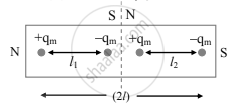Advertisements
Advertisements
Question
Answer the following question in brief.
What happens if a bar magnet is cut into two pieces transverse to its length/along its length?
Solution
- When a magnet is cut into two pieces, then each piece behaves like an independent magnet.
- When a bar magnet is cut transverse to its length, the two pieces generated will behave as independent magnets of reduced magnetic length. However, the pole strength of all the four poles formed will be the same as that of the original bar magnet. Thus, the new dipole moment of the smaller magnets will be,
`therefore m = m xx 2l`
`vec("m"_1)="q"_"m"(vec("l"_1))`, `vec("m"_2)="q"_"m"(vec("l"_2))`
- When the bar magnet is cut along its length, the two pieces generated will behave like an independent magnet with reduced pole strength. However, the magnetic length of both the new magnets will be the same as that of the original bar magnet. Thus, the new dipole moment of the smaller magnets will be
`vec("m"_1)=("q"_"m")_1(2vec("l"))`, `vec("m"_2)=("q"_"m")_2(2vec("l"))`
Pole strength is directly proportional to cross-section area.
APPEARS IN
RELATED QUESTIONS
Magnetic lines of force are closed continuous curves.
How are the magnetic field lines different from the electrostatic field lines?
An iron needle is attracted to the ends of a bar magnet but not to the middle region of the magnet. Is the material making up the ends of a bare magnet different from that of the middle region?
Two bar magnets are placed close to each other with their opposite poles facing each other. In absence of other forces, the magnets are pulled towards each other and their kinetic energy increases. Does it contradict our earlier knowledge that magnetic forces cannot do any work and hence cannot increase kinetic energy of a system?
A bar magnet of length 1 cm and cross-sectional area 1.0 cm2 produces a magnetic field of 1.5 × 10−4 T at a point in end-on position at a distance 15 cm away from the centre. (a) Find the magnetic moment M of the magnet. (b) Find the magnetisation I of the magnet. (c) Find the magnetic field B at the centre of the magnet.
An electron moves along +x direction. It enters into a region of uniform magnetic field. `vecB` directed along –z direction as shown in fig. Draw the shape of the trajectory followed by the electron after entering the field.

Choose the correct option.
Inside a bar magnet, the magnetic field lines
Answer the following question in detail.
A circular magnet is made with its north pole at the centre, separated from the surrounding circular south pole by an air gap. Draw the magnetic field lines in the gap.
A short bar magnet placed with its axis at 30° with a uniform external magnetic field of 0.25 T experiences a torque of magnitude equal to 4.5 × 10–2 J. What is the magnitude of magnetic moment of the magnet?
A closely wound solenoid of 800 turns and area of cross-section 2.5 × 10–4 m2 carries a current of 3.0 A. Explain the sense in which the solenoid acts like a bar magnet. What is its associated magnetic moment?
A closely wound solenoid of 2000 turns and area of cross-section 1.6 × 10–4 m2, carrying a current of 4.0 A, is suspended through its centre allowing it to turn in a horizontal plane.
- What is the magnetic moment associated with the solenoid?
- What is the force and torque on the solenoid if a uniform horizontal magnetic field of 7.5 × 10–2 T is set up at an angle of 30° with the axis of the solenoid?
A closely wound solenoid of 2000 turns and area of cross-section 1.6 × 10-4 m2 , carrying a current of 4.0 A, is suspended through its centre allowing it to turn in a horizontal plane.
What is the force and torque on the solenoid if a uniform horizontal magnetic field of 7.5 × 10-2 T is set up at an angle of 30° with the axis of the solenoid?
In which case of comparing solenoid and bar magnet there is no exact similarity?
Magnetic field at far axial point due to solenoid as well as bar magnet varies ______.
Magnetic moment for solenoid and corresponding bar magnet is ______.
Four point masses, each of value m, are placed at the comers of a square ABCD of side L, the moment of inertia of this system about an axis through A and parallel to BD is ______.
The resistance of ideal voltmeter is
The magnetic moment of atomic neon is equal to
A magnetic needle suspended freely orients itself:-
A bar magnet of magnetic moment 3.0 Am is placed in a uniform magnetic field of 2 × 10-5T. If each pole of the magnet experience a force of 6 × 10-4 N, the length of the magnet is ______.
A ball of superconducting material is dipped in liquid nitrogen and placed near a bar magnet. (i) In which direction will it move? (ii) What will be the direction of it’s magnetic moment?
Verify the Ampere’s law for magnetic field of a point dipole of dipole moment m = m`hatk`. Take C as the closed curve running clockwise along (i) the z-axis from z = a > 0 to z = R; (ii) along the quarter circle of radius R and centre at the origin, in the first quadrant of x-z plane; (iii) along the x-axis from x = R to x = a, and (iv) along the quarter circle of radius a and centre at the origin in the first quadrant of x-z plane.
A bar magnet is demagnetized by inserting it inside a solenoid of length 0.2 m, 100 turns, and carrying a current of 5.2 A. The coercivity of the bar magnet is ______.
